
Click here to download a PDF of Practice Test 2
Section I
The Exam
AP® Physics 1 Exam
SECTION I: Multiple-Choice Questions
At a Glance
Total Time
90 minutes
Number of Questions
50
Percent of Total Grade
50%
Writing Instrument
Pen required
Section I of this examination contains 50 multiple-choice questions. Fill in only the ovals for numbers 1 through 50 on your answer sheet.
CALCULATORS MAY BE USED ON BOTH SECTIONS OF THE AP PHYSICS 1 EXAM.
Indicate all of your answers to the multiple-choice questions on the answer sheet. No credit will be given for anything written in this exam booklet, but you may use the booklet for notes or scratch work. Please note that there are two types of multiple-choice questions: single-select and multi-select questions. After you have decided which of the suggested answers is best, completely fill in the corresponding oval(s) on the answer sheet. For single-select, you must give only one answer; for multi-select you must give BOTH answers in order to earn credit. If you change an answer, be sure that the previous mark is erased completely. Here is a sample question and answer.
Sample Question
Chicago is a
(A) state
(B) city
(C) country
(D) continent
Sample Answer

Use your time effectively, working as quickly as you can without losing accuracy. Do not spend too much time on any one question. Go on to other questions and come back to the ones you have not answered if you have time. It is not expected that everyone will know the answers to all the multiple-choice questions.
Many candidates wonder whether or not to guess the answers to questions about which they are not certain. Multiple-choice scores are based on the number of questions answered correctly. Points are not deducted for incorrect answers, and no points are awarded for unanswered questions. Because points are not deducted for incorrect answers, you are encouraged to answer all multiple-choice questions. On any questions you do not know the answer to, you should eliminate as many choices as you can, and then select the best answer among the remaining choices.
ADVANCED PLACEMENT PHYSICS 1 TABLE OF INFORMATION

ADVANCED PLACEMENT PHYSICS 1 EQUATIONS

AP PHYSICS 1
SECTION I
Note: To simplify calculations, you may use g = 10 m/s2 in all problems.
Directions: Each of the questions or incomplete statements is followed by four suggested answers or completions. Select the one that is best in each case and then fill in the corresponding circle on the answer sheet.
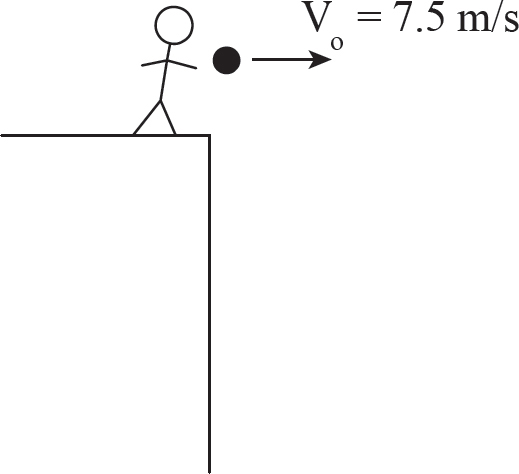
1. An object is thrown horizontally to the right off a high cliff with an initial speed of 7.5 m/s. Which arrow best represents the direction of the object’s velocity after 2 seconds? (Assume air resistance is negligible.)
(A) 
(B) 
(C) 
(D) 
Questions 2–4 refer to the following figure:
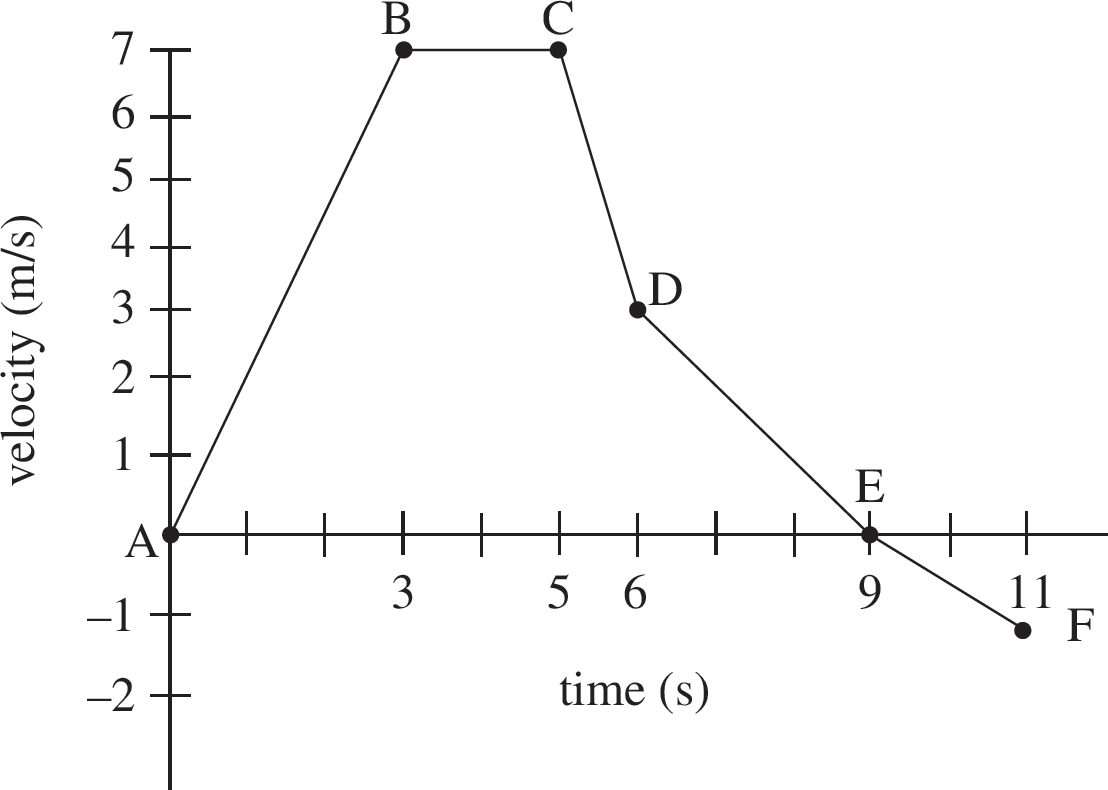
2. Rank the change in momentum for each segment from least (most negative) to greatest (most positive). Assume that the mass of the object remains constant.
(A) BC, EF, DE, AB, CD
(B) AB, CD, DE, EF, BC
(C) BC, EF, DE, CD, AB
(D) CD, DE, EF, BC, AB
3. During which segment is the magnitude of average acceleration greatest?
(A) AB
(B) BC
(C) CD
(D) DE

5. A ball is thrown with an initial velocity v at an angle θ above the ground. If the acceleration due to gravity is −g, which of the following is the correct expression of the time it takes for the ball to reach its highest point, y, from the ground?
(A) v2 sin θ/g
(B) −v cos θ/g
(C) v sin θ/g
(D) v2 cos θ/g

6. A bubble in a glass of water releases from rest at the bottom of the glass and rises at acceleration a to the surface in t seconds. How much farther does the bubble travel in its last second than in its first second? Assume that the journey takes longer than 2 seconds.
(A) a(t + 1 s)2
(B) a(t − 1 s)(1 s)
(C) at2
(D) a(t + 1 s)(1 s)

7. A person standing on a horizontal floor is acted upon by two forces: the downward pull of gravity and the upward normal force of the floor. These two forces
(A) have equal magnitudes and form an action/reaction pair
(B) have equal magnitudes and do not form an action/reaction pair
(C) have unequal magnitudes and form an action/reaction pair
(D) have unequal magnitudes and do not form an action/reaction pair
8. Which of the following graphs best represents the force of friction on an object starting at rest that eventually starts sliding across a level surface due to a gradually increasing horizontal force?

9. Two objects have a mass 1 kg and carry a charge of magnitude 1 C each. Which statement correctly identifies the relationship between the magnitude of the force of gravity, Fg, and the magnitude of the electric force, FE, between the objects?
(A) Fg > FE
(B) Fg < FE
(C) Fg = FE
(D) Cannot be determined without knowing the sign of the charges
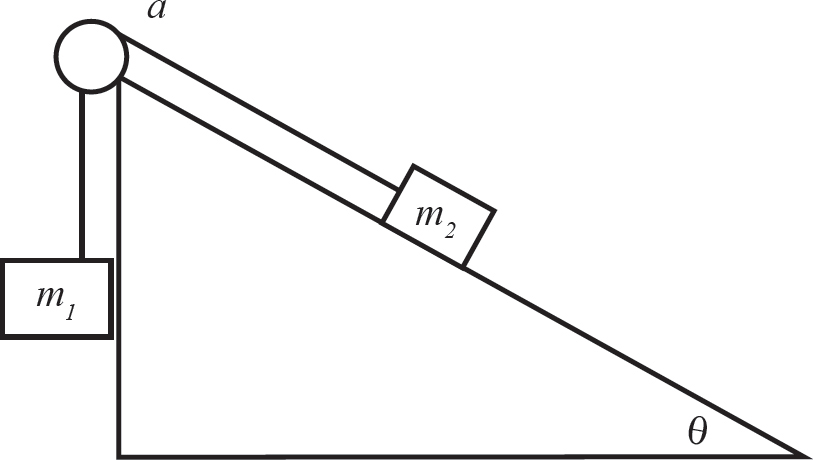
10. Consider the above configuration of masses attached via a massless rope and pulley over a frictionless inclined plane. What is the acceleration of the masses?
(A) (m1 − m2) g/(m1 + m2)
(B) (m1 − m2 sin θ) g/(m1 + m2)
(C) (m1 − m2 cos θ) g/(m1 + m2)
(D) g
11. A person is pulling a block of mass m with a force equal to its weight directed 30° above the horizontal plane across a rough surface, generating a friction f1 on the block. If the person is now pushing downward on the block with the same force 30° below the horizontal plane across the same rough surface, what is the friction on the block? (μk is the coefficient of kinetic friction across the surface.)
(A) f
(B) 1.5f
(C) 2f
(D) 3f

12. In the figure above, two blocks of mass 3m and 2m are attached together. The plane is frictionless and the pulley is frictionless and massless. The inclined portion of the plane creates an angle θ with the horizontal floor. What is the acceleration of the block 2m if both blocks are released from rest (gravity = g)?
(A) 2mg
(B)  g sin θ
g sin θ
(C) 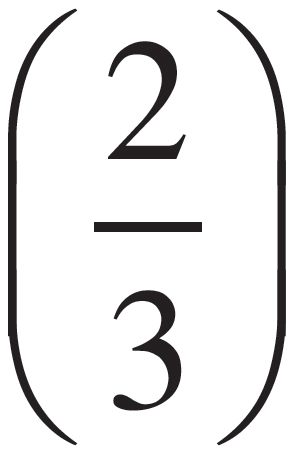 g sin θ
g sin θ
(D) 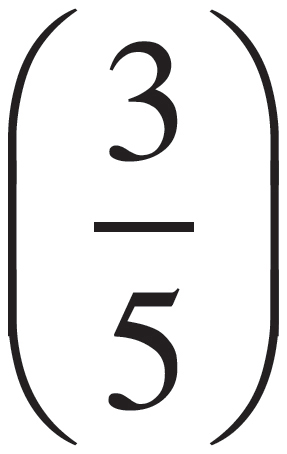 g sin θ
g sin θ

13. If a roller coaster cart of mass m was not attached to the track, it would still remain in contact with a track throughout a loop of radius r as long as
(A) v≤
(B) v≥
(C) v≤
(D) v≥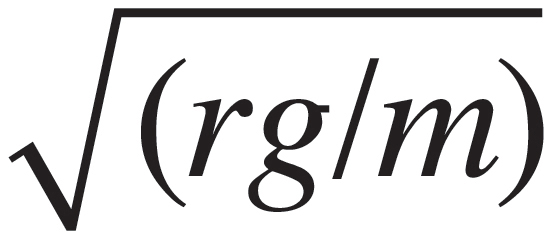

14. The diagram above shows a top view of an object of mass M on a circular platform of mass 2M that is rotating counterclockwise. Assume the platform rotates without friction. Which of the following best describes an action by the object that will increase the angular speed of the entire system?
(A) The object moves toward the center of the platform, increasing the total angular momentum of the system.
(B) The object moves toward the center of the platform, decreasing the rotational inertia of the system.
(C) The object moves away from the center of the platform, increasing the total angular momentum of the system.
(D) The object moves away from the center of the platform, decreasing the rotational inertia of the system.

15. A moon has an elliptical orbit about the planet as shown above. The moon’s mass is much smaller than the planet’s. Which of the following quantities is/are (approximately) conserved as the moon moves from point A to point B ?
I. The moon’s mechanical energy
II. The moon’s angular momentum
III. The moon’s (linear) momentum
(A) I and II only
(B) I and III only
(C) II and III only
(D) I, II, and III
16. A sphere starts from rest atop a hill with a constant angle of inclination and is allowed to roll without slipping down the hill. What force provides the torque that causes the sphere to rotate?
(A) Static friction
(B) Kinetic friction
(C) The normal force of the hill on the sphere
(D) Gravity
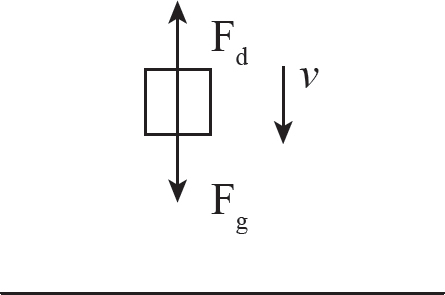
17. Which of the following correctly describes the motion of a real object in free fall? Assume that the object experiences drag force proportional to speed and that it strikes the ground before reaching terminal speed.
(A) It will fall with increasing speed and increasing acceleration.
(B) It will fall with increasing speed and decreasing acceleration.
(C) It will fall with decreasing speed and increasing acceleration.
(D) It will fall with decreasing speed and decreasing acceleration.
18. Which of the following concerning uniform circular motion is true?
(A) The centrifugal force is the action/reaction pair of the centripetal force.
(B) The centripetal acceleration and velocity point in the same direction.
(C) The velocity of the object in motion changes, whereas the acceleration of the object is constant.
(D) A satellite undergoing uniform circular motion is falling toward the center even though its path is circular.

19. A girl of mass m and a boy of mass 2m are sitting on opposite sides of a lightweight seesaw with its fulcrum in the center. Right now, the boy and girl are equally far from the fulcrum, and it tilts in favor of the boy. Which of the following would NOT be a possible method to balance the seesaw?
(A) Move the boy to half his original distance from the fulcrum.
(B) Move the girl to double her original distance from the fulcrum.
(C) Allow a second girl of mass m to join the first.
(D) Move the fulcrum to half its original distance from the boy.

20. Earth’s orbit around the Sun can be approximated as a circle. Given that the Earth’s mass is m, its tangential speed as it revolves around the Sun is v, and the distance from the Sun to the Earth is r, which of the following correctly describes the work done by the centripetal force, Wc, in one year’s time?
(A) Wc > 2r(mv2/r)
(B) Wc = 2r(mv2/r)
(C) Wc < 2r(mv2/r)
(D) Cannot be determined

21. A wooden block experiences a frictional force, Ff, as it slides across a table. If a block of the same material with half the height and twice the length were to slide across the table in the same direction, what would be the frictional force it experienced?
(A) (1/2)Ff
(B) Ff
(C) 2Ff
(D) 4Ff

22. Two objects, a sphere and a block of the same mass, are released from rest at the top of an inclined plane. The sphere rolls down the inclined plane without slipping. The block slides down the plane without friction. Which object reaches the bottom of the ramp first?
(A) The sphere, because it gains rotational kinetic energy, but the block does not
(B) The sphere, because it gains mechanical energy due to the torque exerted on it, but the block does not
(C) The block, because it does not lose mechanical energy due to friction, but the sphere does
(D) The block, because it does not gain rotational kinetic energy, but the sphere does

23. In the diagram above, each of the three frictionless tracks shown here contains an object of mass m. Each object starts at point A with the same initial horizontal velocity v0, which in each case is sufficient to allow the object to reach the end of the track at point B. (Path 1 is directed up, path 2 is directed horizontally, and path 3 is directed down.) The masses remain in contact with the tracks throughout their motions. The displacement A to B is the same in each case, and the total path lengths of path 1 and 3 are equal. If t1, t2, and t3 are the total travel times between A and B for paths 1, 2, and 3, respectively, what is the relation among these times?
(A) t3 < t2 < t1
(B) t2 < t3 < t1
(C) t2 < t1 = t3
(D) t2 = t3 < t1

24. An object of mass m1 experiences a linear, elastic collision with a stationary object of unknown mass. In addition to m1, what is the minimum necessary information that would allow you to determine the mass of the second object?
(A) The final velocity of object 1
(B) The initial speed of object 1
(C) The final velocity of object 2
(D) Any 2 of the above values
25. A block is dragged along a table and experiences a frictional force, f, that opposes its movement. The force exerted on the block by the table is
(A) zero
(B) parallel to the table
(C) perpendicular to the table
(D) neither parallel nor perpendicular to the table
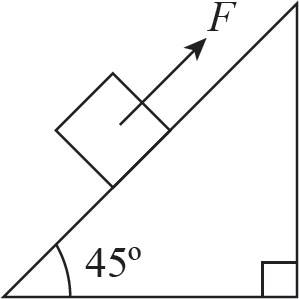
26. A box of mass m is sitting on an incline of 45° and it requires an applied force F up the incline to get the box to begin to move. What is the maximum coefficient of static friction?
(A) 
(B) 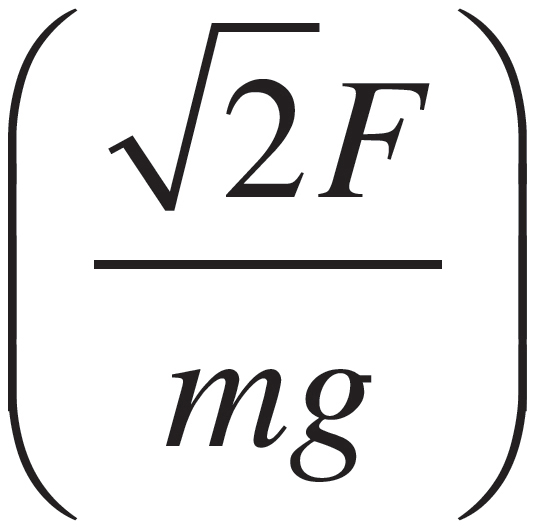
(C) 
(D) 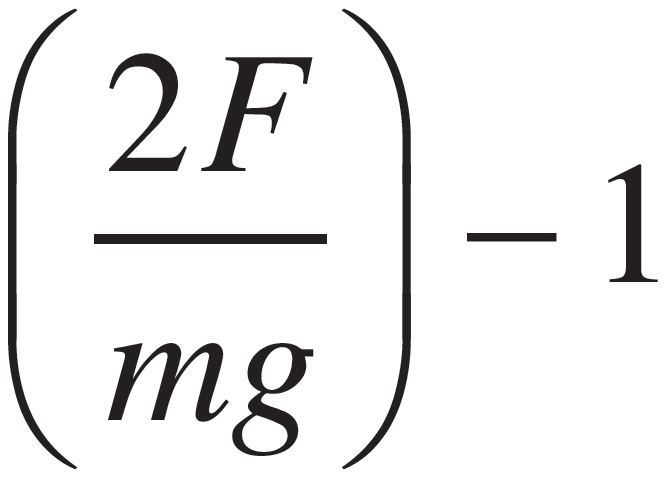

27. The graph above shows the velocities of two objects undergoing a head-on collision. Given that Object 2 has 4 times the mass of Object 1, which type of collision is it?
(A) Perfectly elastic
(B) Perfectly inelastic
(C) Inelastic
(D) Cannot be determined

28. The picture above depicts the collision of two balls of equal mass. Which arrow best indicates the direction of the impulse on Ball A from Ball B during the collision?
(A) 
(B) 
(C) 
(D) 
29. Which of the following best describes the relationship between the magnitude of the tension force, FT, in the string of a pendulum and the radial component of gravity that pulls antiparallel to the tension, Fg, radial? Assume that the pendulum is only displaced by a small amount.
(A) FT > Fg, radial
(B) FT ≥ Fg, radial
(C) FT = Fg, radial
(D) FT ≤ Fg, radial
30. Pretend someone actually managed to dig a hole straight through the center of the Earth all the way to the other side. If an object were dropped down that hole, which of the following would best describe its motion? Assume there is no drag or friction, the Earth is a perfect sphere, and the object cannot be destroyed.
(A) It would fall to the center of the Earth and stop there.
(B) It would fall through the hole to the other side, continue past the opposite side’s opening, and fly into space.
(C) It would oscillate back and forth from one opening to the other indefinitely.
(D) It would fall to the other side and stop there.
31. A sound wave with frequency f travels through air at speed v. With what speed will a sound wave with frequency 4f travel through the air?
(A) v/4
(B) v
(C) 2v
(D) 4v
32. If an object’s kinetic energy is doubled, what happens to its speed?
(A) It increases by a factor of 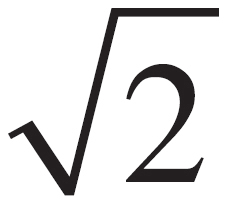 /2.
/2.
(B) It increases by a factor of  .
.
(C) It is doubled.
(D) It is quadrupled.
33. A toy car and a toy truck collide. If the toy truck’s mass is double the toy car’s mass, then, compared to the acceleration of the truck, the acceleration of the car during the collision will be
(A) double the magnitude and in the same direction
(B) double the magnitude and in the opposite direction
(C) half the magnitude and in the same direction
(D) half the magnitude and in the opposite direction
34. The Gravitron is a carnival ride that looks like a large cylinder. People stand inside the cylinder against the wall as it begins to spin. Eventually, it is rotating fast enough that the floor can be removed without anyone falling. Given that the coefficient of friction between a person’s clothing and the wall is μ, the tangential speed is v, and the radius of the ride is r, what is greatest mass that a person can be to safely go on this ride?
(A) μv2/(rg)
(B) r2v2/(µg)
(C) rg/(µv2)
(D) None of the above
35. In a spring-block oscillator, the maximum speed of the block is
(A) proportional to amplitude
(B) proportional to the square of amplitude
(C) proportional to the square root of amplitude
(D) inversely proportional to the square root of amplitude
36. A student is experimenting with a simple spring-block oscillator of spring constant k and amplitude A. The block attached to the spring has a mass of M. If the student places a small block of mass m on top of the original block, which of the following is true?
(A) The small block is most likely to slide off when the original block is at maximum displacement from the equilibrium position, but will not slide off as long as the coefficient of static friction between the blocks is greater than kA/[(M+m)g].
(B) The small block is most likely to slide off when the original block is at the equilibrium position, but will not slide off as long as the coefficient of static friction between the blocks is greater than kA/[(M+m)g].
(C) The small block is most likely to slide off when the original block is at maximum displacement from the equilibrium position, but will not slide off as long as the coefficient of static friction between the blocks is greater than (M+m)g/(kA).
(D) The small block is most likely to slide off when the original block is at the equilibrium position, but will not slide off as long as the coefficient of static friction between the blocks is greater than (M+m)g/(kA).
37. A flute supports standing waves with pressure nodes at each end. The lowest note a flute can play is 261.63 Hz. What is the approximate length of the flute? (speed of sound in air = 343 m/s)
(A) 32.8 cm
(B) 65.6 cm
(C) 76.3 cm
(D) 131 cm
38. You are standing on a railroad track as a train approaches at a constant velocity. Suddenly the engineer sees you, applies the brakes, and sounds the whistle. Which of the following describes the sound of the whistle while the train is slowing down, as you hear it?
(A) Loudness increasing, pitch increasing
(B) Loudness increasing, pitch constant
(C) Loudness decreasing, pitch increasing
(D) Loudness increasing, pitch decreasing
Questions 39–41 refer to the following figure:

39. Determine the total power dissipated through the circuit shown above in terms of V, R1, R2, and R3.
(A) 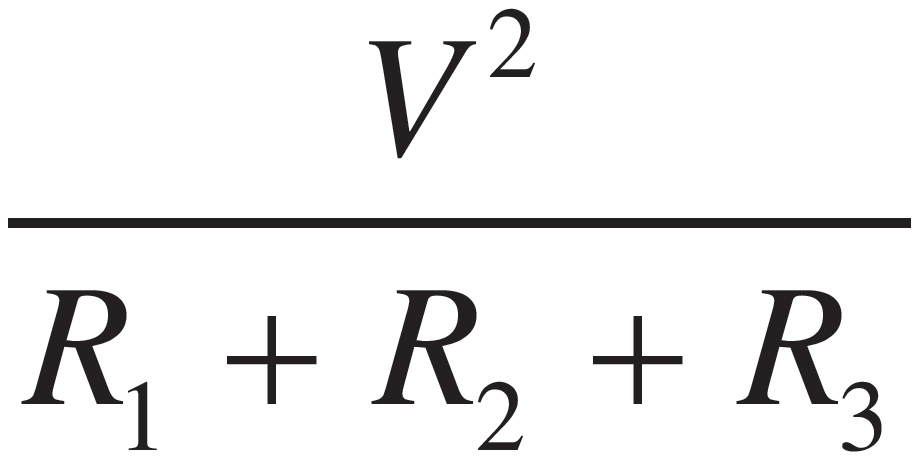
(B) 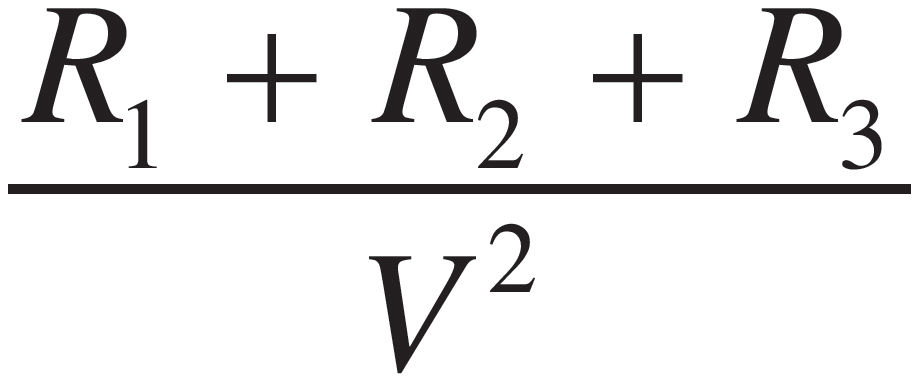
(C) 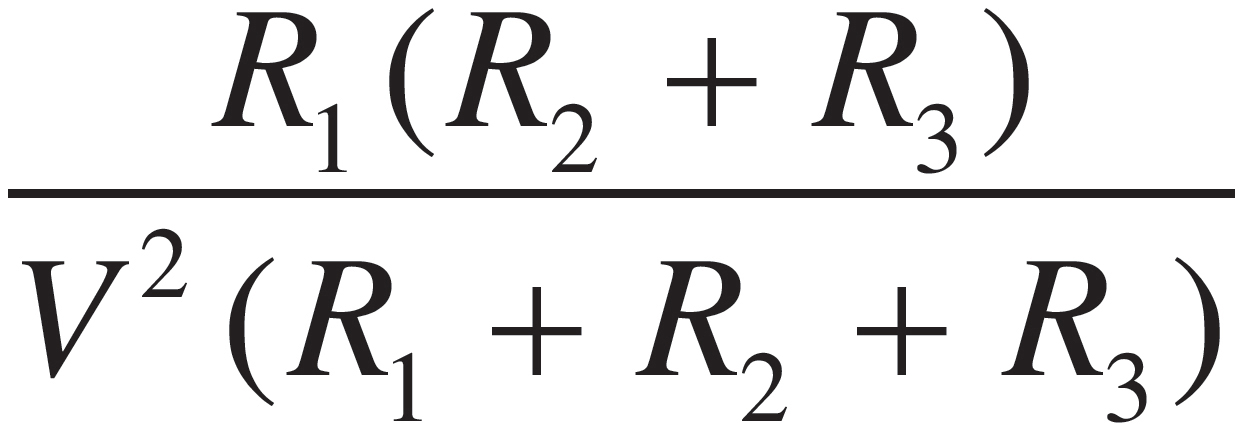
(D) 
40. If V = 100 V, R1 = 50 Ω, R2 = 80 Ω, and R3 = 120 Ω, determine the voltage across R3.
(A) 100 V
(B) 60 V
(C) 40 V
(D) 20 V
41. If R1 were to burn out, the current coming out from the battery would
(A) increase
(B) decrease
(C) stay the same
(D) There is no current, because the circuit is now incomplete.
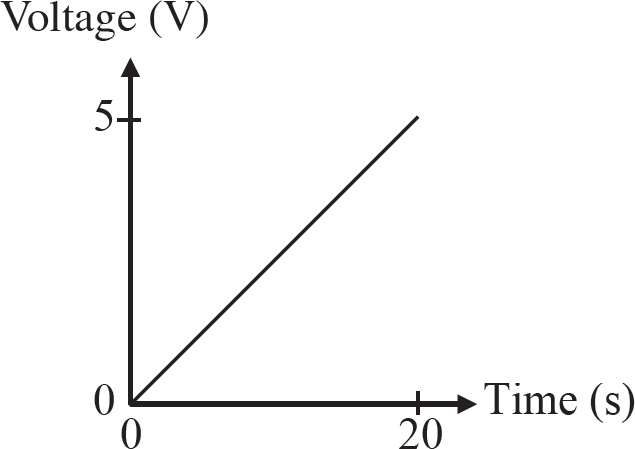
42. A circuit consists of a 500 Ω resistor connected to a variable voltage source. The voltage is increased linearly from 0 V to 5 V over a period of 20 s, as shown in the graph above. Which of the following graphs corresponds to the power dissipated by the resistor as a function of time?
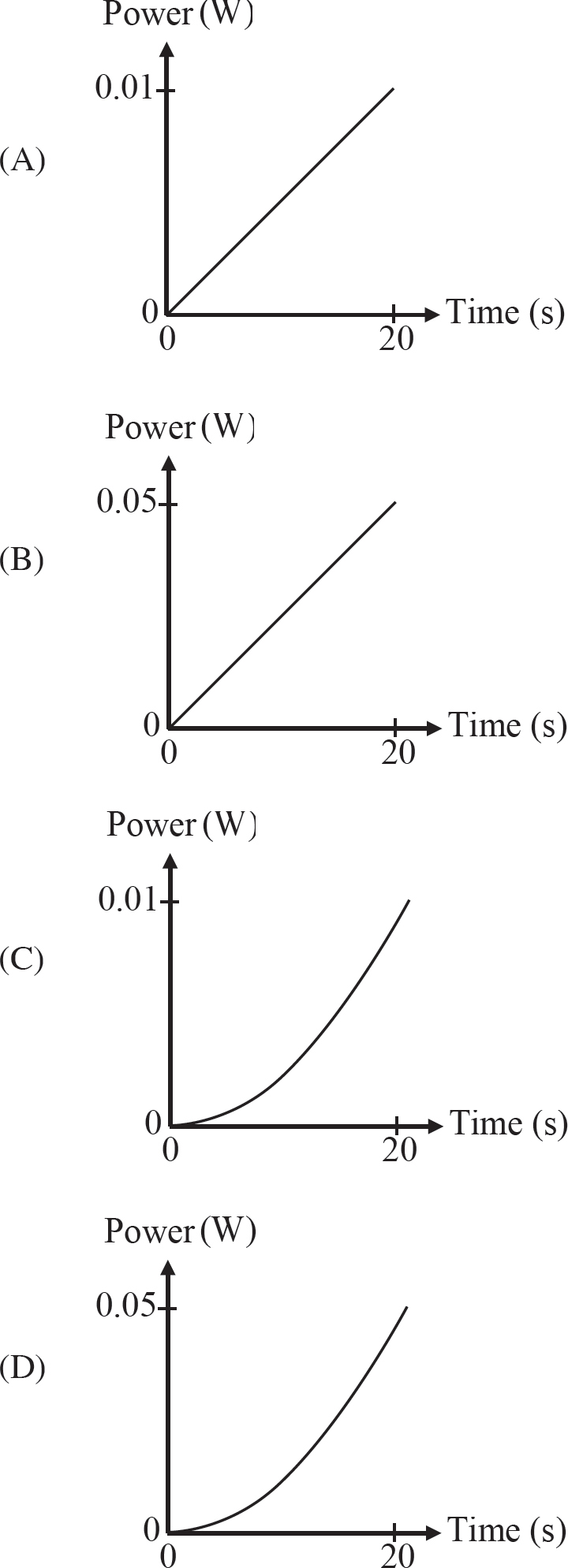

43. A Wheatstone bridge (diagram above) is a configuration of resistors and a sensitive current meter, called a galvanometer, that is used to determine the resistance of an unknown resistor. In the Wheatstone bridge shown here, find the value of Rx such that the current through galvanometer G is zero.
(A) 25 Ω
(B) 15 Ω
(C) 10 Ω
(D) 2.5 Ω
44. What happens to the electric force between two point charges if the magnitude of both charges is doubled, and the distance between them is halved?
(A) The force is halved.
(B) The force remains the same.
(C) The force is quadrupled.
(D) The force increases by a factor of 16.

45. In the figure above, four charges are arranged. If the magnitudes of all the charges q are all the same and the distance r between them is as shown above, what is the magnitude of the net force on the bottom right charge in terms of q, r, and k (where  )?
)?
(A) 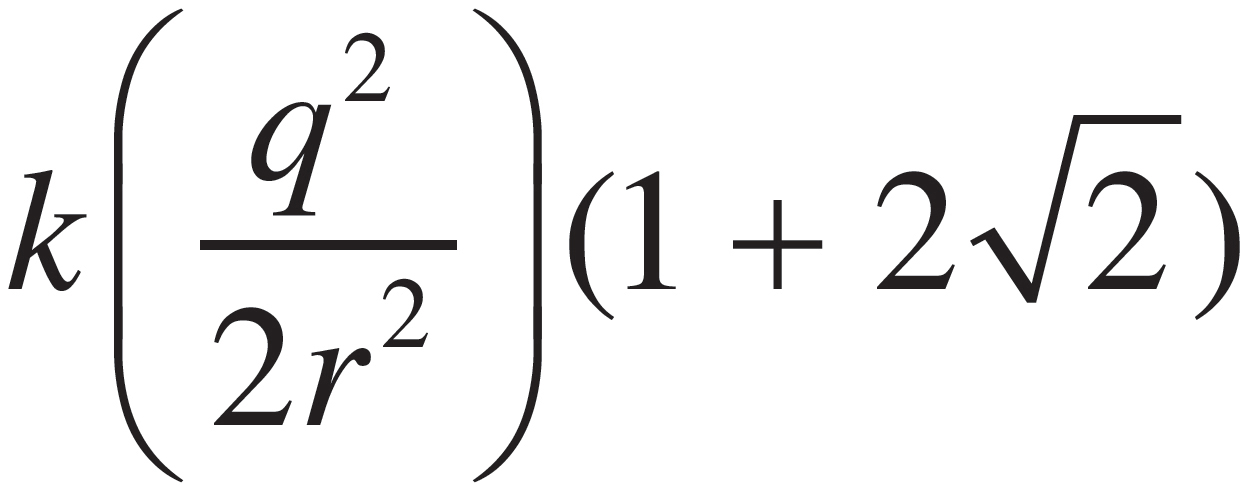
(B) 
(C) 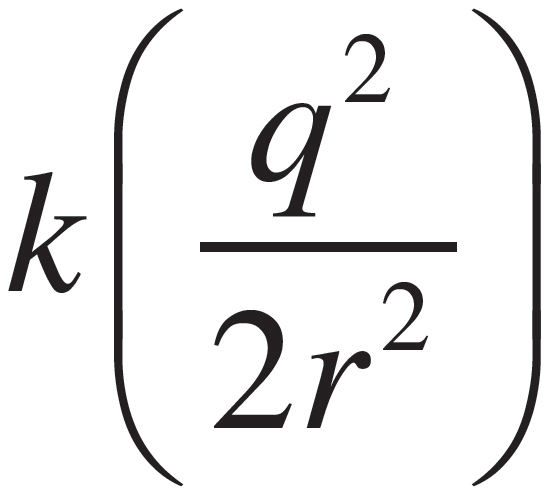
(D) 
Directions: For each of the questions 46–50, two of the suggested answers will be correct. Select the two answers that are best in each case, and then fill in both of the corresponding circles on the answer sheet.
46. An object traveling at x m/s can stop at a distance d m with a maximum negative acceleration. If the car is traveling at 2x m/s, which of the following statements are true? Select two answers.
(A) The stopping time is doubled.
(B) The stopping time is quadrupled.
(C) The stopping distance is doubled.
(D) The stopping distance is quadrupled.

47. A 2 kg mass is attached to a massless, 0.5 m string and is used as a simple pendulum by extending it to an angle θ = 5° and allowing it to oscillate. Which of the following changes will change the period of the pendulum? Select two answers.
(A) Replacing the mass with a 1 kg mass
(B) Changing the initial extension of the pendulum to a 10° angle
(C) Replacing the string with a 0.25 m string
(D) Moving the pendulum to the surface of the Moon
48. N resistors (N > 2) are connected in parallel with a battery of voltage Vo. If one of the resistors is removed from the circuit, which of the following quantities will decrease? Select two answers.
(A) The voltage across any of the remaining resistors
(B) The current output by the battery
(C) The total power dissipated in the circuit
(D) The voltage supplied by the battery

49. Which of the following will decrease the current through R3 in the circuit above? Select two answers.
(A) A decrease in R1
(B) An increase in R1
(C) An increase in R2
(D) An increase in R3
50. A sound wave travels through a metal rod with wavelength λ and frequency f. Which of the following are true? Select two answers.
(A) When this sound wave passes into air, the frequency will change.
(B) When this sound wave passes into air, the wavelength will change.
(C) While in the metal rod, the λ and frequency f have a direct relationship.
(D) While in the metal rod, the λ and frequency f have an inverse relationship.
END OF SECTION I
DO NOT CONTINUE UNTIL INSTRUCTED TO DO SO.
Section II
AP PHYSICS 1
SECTION II
Free-Response Questions
Time—90 minutes
Percent of total grade—50
General Instructions
Use a separate piece of paper to answer these questions. Show your work. Be sure to write CLEARLY and LEGIBLY. If you make an error, you may save time by crossing it out rather than trying to erase it.
AP PHYSICS 1
SECTION II
Directions: Questions 1, 2, and 3 are short free-response questions that require about 13 minutes to answer and are worth 8 points each. Questions 4 and 5 are long free-response questions that require about 25 minutes each to answer and are worth 13 points each. Show your work for each part in the space provided after that part.

1. An experiment is conducted in which Block A with a mass of mA is slid to the right across a frictionless table. Block A collides with Block B, which is initially at rest, of an unknown mass and sticks to it.
(a) Describe an experimental procedure that determines the velocities of the blocks before and after a collision. Include all the additional equipment you need. You may include a labeled diagram of your setup to help in your description. Indicate what measurements you would take and how you would take them. Include enough detail so that the experiment could be repeated with the procedure you provide.
(b) If Block A has a mass of 0.5 kg and starts off with a speed of 1.5 m/s and the experiment is repeated, the velocity of the blocks after they collide are recorded to be 0.25 m/s. What is the mass of Block B?
(c) How much kinetic energy was lost in this collision from part (b)?
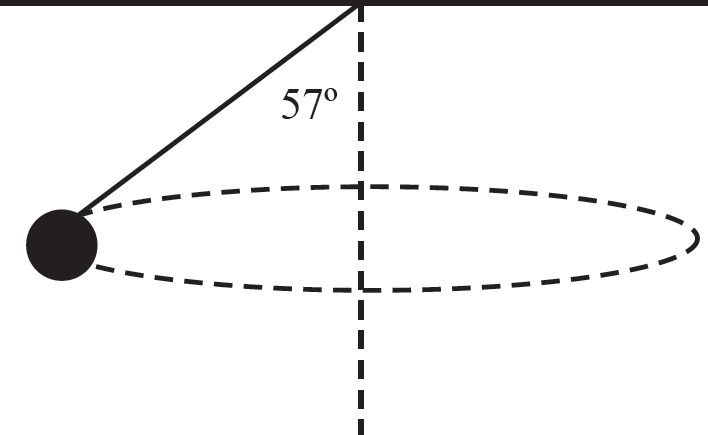
2. A conical pendulum is hanging from a string that is 2.2 meters long. It makes a horizontal circle. The mass of the ball at the end of the string is 0.5 kg.
(a) Below, make a free-body diagram for the ball at the point shown in the above illustration. Label each force with an appropriate letter.

(b) Write out Newton’s Second Law in both the x- and y-direction in terms used in your free-body diagram.
(c) Calculate the centripetal acceleration from your free-body diagram.
(d) What is the radius of the circle that the ball is traveling in?
(e) What is the speed of the ball?
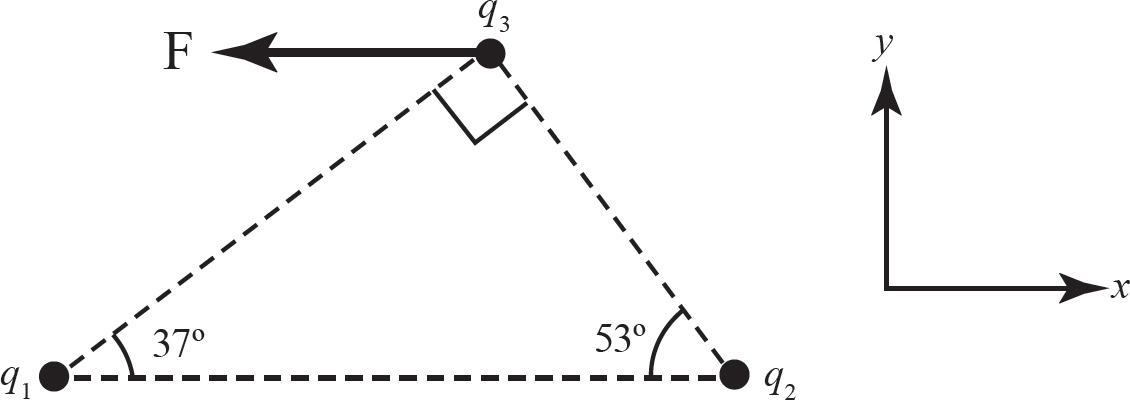
3. Three particles are fixed in place in a horizontal plane, as shown in the figure above. Particle 1 has a charge that has a magnitude of 4.0 × 10−6 C and the sign of the charge is unknown. Particle 2 has a charge that has a magnitude of 1.7 × 10−6 C and the sign of the charge is unknown. Particle 3 has a charge of +1.0 × 10−6 C. The distance between q1 and q2 is 5.0 m, the distance between q2 and q3 is 3.0 m, and the distance between q1 and q3 is 4.0 m. The electrostatic force F on particle 3 due to the other two charges is shown in the negative x-direction.
(a) Determine the signs of the charges of q1 and q2.
(b) On the diagram below, draw and label the force F1 of the force exerted by Particle 1 on Particle 3 and the force F2 of the force exerted by Particle 2 on Particle 3.
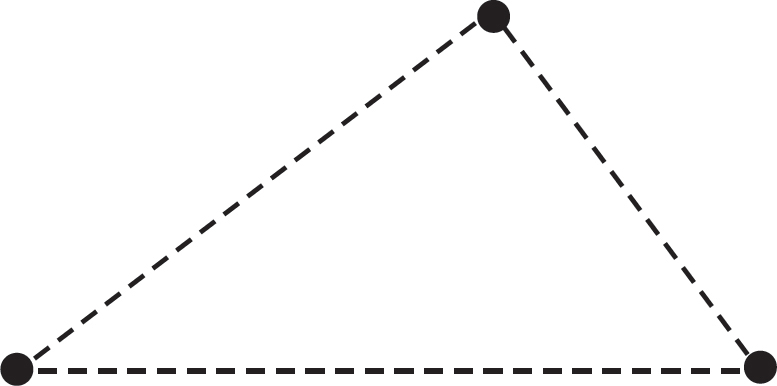
(c) Calculate the magnitude of the electrostatic force on Particle 3.
(d) Draw and label clearly where another positively charged particle could be placed so the net electrostatic force on Particle 3 is zero.

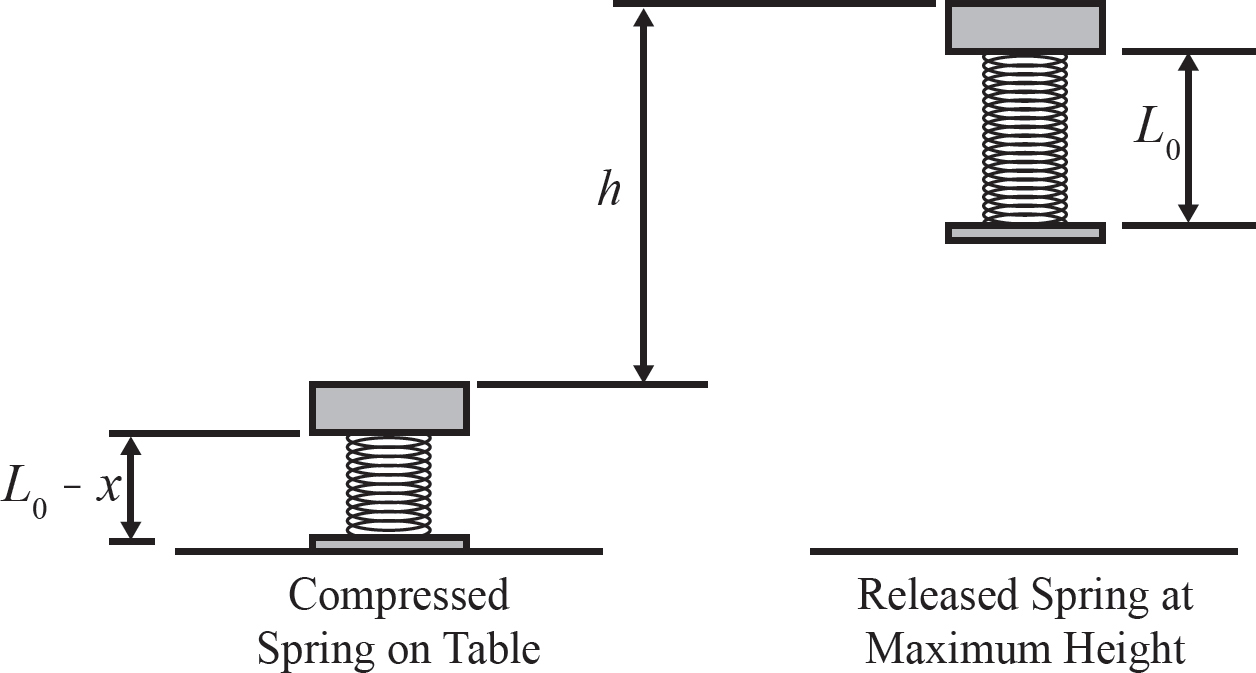
4. An experiment is designed to calculate the spring constant k of a vertical spring for a jumping toy. The toy is compressed a distance of x from its natural length of L0, as shown on the left in the diagram, and then released. When the toy is released, the top of the toy reaches a height of h in comparison to its previous height and the spring reaches its maximum extension. The experiment is repeated multiple times and replaced with different masses m attached to the spring. The spring itself has negligible mass.
(a) Derive an expression for the height h in terms of m, x, k, and any other constants provided in the formula sheet.
(b) To standardize the experiment, the compressed distance x is set to 0.020 m. The following table shows the data for different values of m.
|
|
m (kg) |
h(m) |
|
|
0.020 |
0.49 |
|
|
0.030 |
0.34 |
|
|
0.040 |
0.28 |
|
|
0.050 |
0.19 |
|
|
0.060 |
0.18 |
(i) What quantities should be graphed so that the slope of a best-fit straight line through the data points can help us calculate the spring constant k?
(ii) Fill in the blank column in the table above with calculated values. Also include a header with units.
(c) On the axes below, plot the data and draw the best-fit straight line. Label the axes and indicate scale.
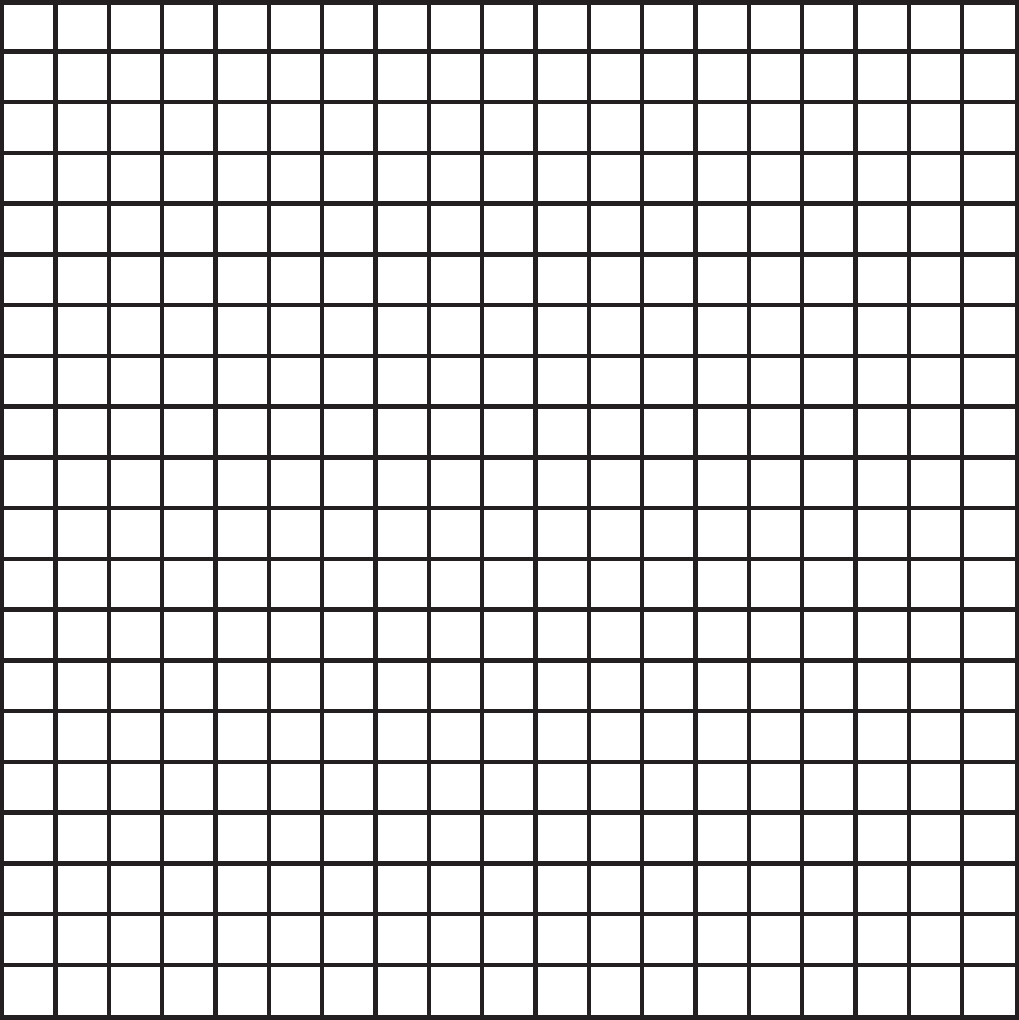
(d) Using your best-fit line, calculate the numerical value of the spring constant.
(e) Describe an experimental procedure that determines the height h in the experiment, given that the toy is only momentarily at that maximum height. You may include a labeled diagram of your setup to help in your description.

5. In the above diagram, two small objects, each with a charge of −4.0 nC, are held together by a 0.020 m length of insulating string. The objects are initially at rest on a horizontal, non-conducting, frictionless surface. The effects of gravity on each other can be considered negligible.
(a) Calculate the tension in the string.
(b) Illustrate the electric field by drawing electric field lines for the two objects on the following diagram.

The masses of the objects are m1 = 0.030 kg and m2 = 0.060 kg. The string is now cut.
(c) Calculate the magnitude of the initial acceleration of each object.
(d) On the axes below, sketch a graph of the acceleration a of the object of mass m2 versus the distance d between the objects after the string has been cut.
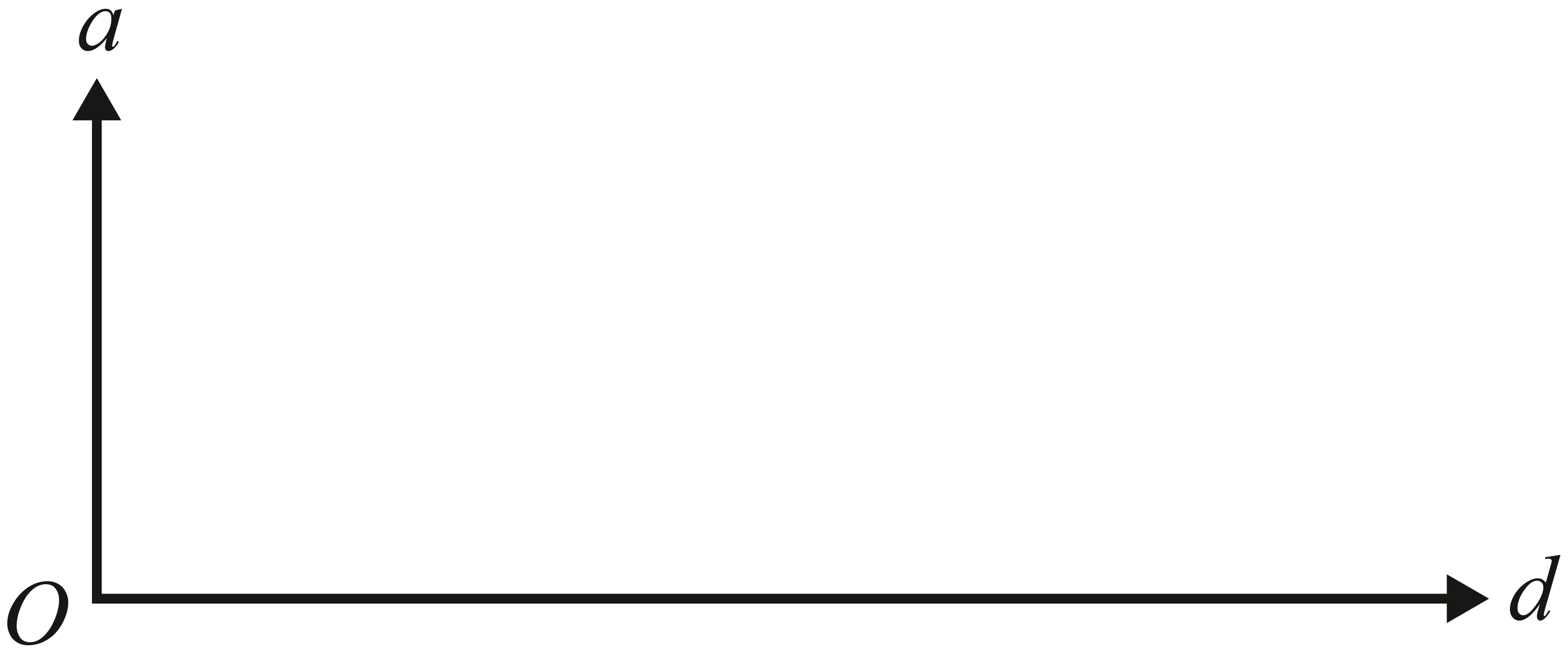
(e) In a brief paragraph, describe the speed of the objects as time increases, assuming that the objects remain on the horizontal, non-conducting frictionless surface.
STOP
END OF EXAM